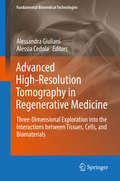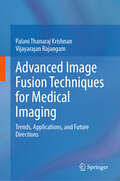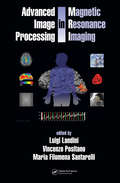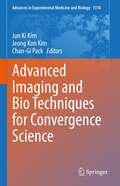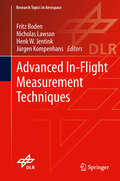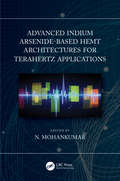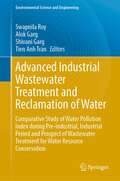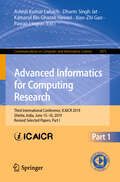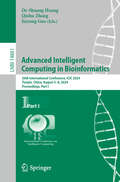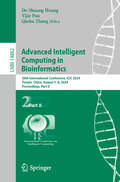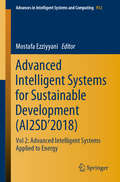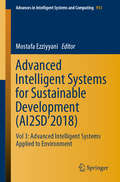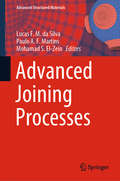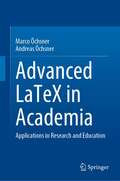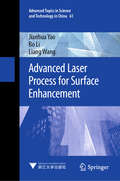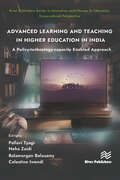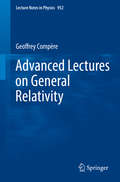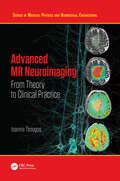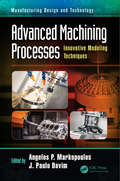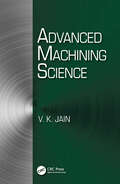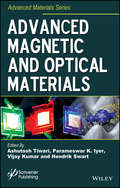- Table View
- List View
Advanced High-Resolution Tomography in Regenerative Medicine: Three-Dimensional Exploration into the Interactions between Tissues, Cells, and Biomaterials (Fundamental Biomedical Technologies)
by Alessandra Giuliani Alessia CedolaThis book covers the state-of-the-art research on advanced high-resolution tomography, exploring its role in regenerative medicine. and also explores the 3D interactions between tissues, cells, and biomaterials. Various multidisciplinary paths in regenerative medicine are covered, including X-ray microtomography and its role in regenerative medicine, synchrotron radiation-based microtomography and phase contrast tomography, the challenge of the vascularization of regenerated tissues, lung and cartilage imaging, and more. This is an ideal book for biomedical engineers, biologists, physicists, clinicians, and students who want to pursue their studies in the field of regenerative medicine.This book also:Reviews in detail the algorithms and software used for the 3D exploration of regenerated tissueCovers the latest research on the use of X-ray microtomography for muscle diseasesDetails applications of synchrotron radiation tomography in orthopedics and dentistry
Advanced Image Fusion Techniques for Medical Imaging: Trends, Applications, and Future Directions
by Palani Thanaraj Krishnan Vijayarajan Rajangam"Advanced Image Fusion Techniques for Medical Imaging: Trends, Applications, and Future Directions" is a comprehensive exploration of cutting-edge image fusion methodologies in the realm of medical imaging. This timely work addresses the growing need for advanced techniques to integrate and analyze multi-modal medical images, offering healthcare professionals and researchers a valuable resource for improving diagnostic accuracy and patient outcomes. The book provides a thorough examination of both conventional and deep learning-based fusion strategies, covering a wide spectrum of applications in medical image processing. From noise reduction and image enhancement to segmentation and classification, the authors present a detailed analysis of how image fusion can be leveraged to overcome the limitations of individual imaging modalities. Real-world case studies and practical examples throughout the text demonstrate the tangible benefits of these techniques in clinical settings. Looking beyond current applications, this forward-thinking volume also explores emerging trends and future directions in medical image fusion. By addressing challenges and potential impacts on healthcare practices, the authors offer readers a glimpse into the future of medical imaging. This book serves as an essential guide for researchers in biomedical engineering, medical professionals specializing in radiology and medical imaging, and graduate students in computer science, electrical engineering, biomedical engineering. This diverse audience reflects the book's comprehensive approach to advanced image fusion techniques in medical imaging, covering both theoretical foundations and practical applications.
Advanced Image Processing in Magnetic Resonance Imaging (Signal Processing and Communications)
by Luigi Landini Vincenzo Positano Maria Filomena SantarelliThe popularity of magnetic resonance (MR) imaging in medicine is no mystery: it is non-invasive, it produces high quality structural and functional image data, and it is very versatile and flexible. Research into MR technology is advancing at a blistering pace, and modern engineers must keep up with the latest developments. This is only possible with a firm grounding in the basic principles of MR, and Advanced Image Processing in Magnetic Resonance Imaging solidly integrates this foundational knowledge with the latest advances in the field.Beginning with the basics of signal and image generation and reconstruction, the book covers in detail the signal processing techniques and algorithms, filtering techniques for MR images, quantitative analysis including image registration and integration of EEG and MEG techniques with MR, and MR spectroscopy techniques. The final section of the book explores functional MRI (fMRI) in detail, discussing fundamentals and advanced exploratory data analysis, Bayesian inference, and nonlinear analysis. Many of the results presented in the book are derived from the contributors' own work, imparting highly practical experience through experimental and numerical methods.Contributed by international experts at the forefront of the field, Advanced Image Processing in Magnetic Resonance Imaging is an indispensable guide for anyone interested in further advancing the technology and capabilities of MR imaging.
Advanced Imaging and Bio Techniques for Convergence Science (Advances in Experimental Medicine and Biology #1310)
by Jun Ki Kim Jeong Kon Kim Chan-Gi PackThis book is a wide-ranging guide to advanced imaging techniques and related methods with important applications in translational research or convergence science as progress is made toward a new era in integrative healthcare. Conventional and advanced microscopic imaging techniques, including both non-fluorescent (i.e., label-free) and fluorescent methods, have to date provided researchers with specific and quantitative information about molecules, cells, and tissues. Now, however, the different imaging techniques can be correlated with each other and multimodal methods developed to simultaneously obtain diverse and complementary information. In addition, the latest advanced imaging techniques can be integrated with non-imaging techniques such as mass spectroscopic methods, genome editing, organic/inorganic probe synthesis, nanomedicine, and drug discovery. The book will be of high value for researchers in the biological and biomedical sciences or convergence science who need to use these multidisciplinary and integrated techniques or are involved in developing new analytical methods focused on convergence science.
Advanced In-Flight Measurement Techniques (Research Topics in Aerospace)
by Fritz Boden Henk W. Jentink Jürgen Kompenhans Nicholas LawsonThe book presents a synopsis of the main results achieved during the 3 year EU-project "Advanced Inflight Measurement Techniques (AIM)" which applied advanced image based measurement techniques to industrial flight testing. The book is intended to be not only an overview on the AIM activities but also a guide on the application of advanced optical measurement techniques for future flight testing. Furthermore it is a useful guide for engineers in the field of experimental methods and flight testing who face the challenge of a future requirement for the development of highly accurate non-intrusive in-flight measurement techniques.
Advanced Indium Arsenide-Based HEMT Architectures for Terahertz Applications
by N. MohankumarHigh electron mobility transistor (HEMT) has better performance potential than the conventional MOSFETs. Further, InAs is a perfect candidate for the HEMT device architecture owing to its peak electron mobility. Advanced Indium Arsenide-based HEMT Architectures for Terahertz Applications characterizes the HEMT based on InAs III-V material to achieve outstanding current and frequency performance. This book explains different types of device architectures available to enhance performance including InAs-based single gate (SG) HEMT and double gate (DG) HEMT. The noise analysis of InAs-based SG and DG-HEMT is also discussed. The main goal of this book is to characterize the InAs device to achieve terahertz frequency regime with proper device parameters. Features: Explains the influence of InAs material in the performance of HEMTs and MOS-HEMTs. Covers novel indium arsenide architectures for achieving terahertz frequencies Discusses impact of device parameters on frequency response Illustrates noise characterization of optimized indium arsenide HEMTs Introduces terahertz electronics including sources for terahertz applications. This book is of special interest to researchers and graduate students in Electronics Engineering, High Electron Mobility Transistors, Semi-conductors, Communications, and Nanodevices.
Advanced Industrial Wastewater Treatment and Reclamation of Water: Comparative Study of Water Pollution Index during Pre-industrial, Industrial Period and Prospect of Wastewater Treatment for Water Resource Conservation (Environmental Science and Engineering)
by Swapnila Roy Tien Anh Tran Alok Garg Shivani GargThis book focuses on industrial wastes that either join the streams or other natural water bodies directly, or are emptied into the municipal sewers, and their characteristics vary widely depending on the source of production and the raw material used by the industry, even during pre-industrial, industrial period and prospect of wastewater treatment for water resource conservation. The treatment of industrial wastewater can be done in part or as a whole either by the biological or chemical processes. Advanced treatment methods like membrane separation, ultra-filtration techniques and adsorption are elaborated. It would emphasize and facilitate a greater understanding of all existing available research, i.e., theoretical, methodological, well-established and validated empirical work, associated with the environment and climate change aspects.
Advanced Informatics for Computing Research: Third International Conference, ICAICR 2019, Shimla, India, June 15–16, 2019, Revised Selected Papers, Part I (Communications in Computer and Information Science #1075)
by Pawan Lingras Xiao-Zhi Gao Ashish Kumar Luhach Dharm Singh Jat Kamarul Bin Ghazali HawariThis two-volume set (CCIS 1075 and CCIS 1076) constitutes the refereed proceedings of the Third International Conference on Advanced Informatics for Computing Research, ICAICR 2019, held in Shimla, India, in June 2019. The 78 revised full papers presented were carefully reviewed and selected from 382 submissions. The papers are organized in topical sections on computing methodologies; hardware; information systems; networks; software and its engineering.
Advanced Intelligent Computing in Bioinformatics: 20th International Conference, ICIC 2024, Tianjin, China, August 5–8, 2024, Proceedings, Part I (Lecture Notes in Computer Science #14881)
by De-Shuang Huang Jiayang Guo Qinhu ZhangThis two-volume set LNBI 14881-14882 constitutes - in conjunction with the 13-volume set LNCS 14862-14874 and the 6-volume set LNAI 14875-14880 - the refereed proceedings of the 20th International Conference on Intelligent Computing, ICIC 2024, held in Tianjin, China, during August 5-8, 2024. The total of 863 regular papers were carefully reviewed and selected from 2189 submissions. The intelligent computing annual conference primarily aims to promote research, development and application of advanced intelligent computing techniques by providing a vibrant and effective forum across a variety of disciplines. This conference has a further aim of increasing the awareness of industry of advanced intelligent computing techniques and the economic benefits that can be gained by implementing them. The intelligent computing technology includes a range of techniques such as Artificial Intelligence, Pattern Recognition, Evolutionary Computing, Informatics Theories and Applications, Computational Neuroscience & Bioscience, Soft Computing, Human Computer Interface Issues, etc.
Advanced Intelligent Computing in Bioinformatics: 20th International Conference, ICIC 2024, Tianjin, China, August 5–8, 2024, Proceedings, Part II (Lecture Notes in Computer Science #14882)
by De-Shuang Huang Yijie Pan Qinhu ZhangThis two-volume set LNBI 14881-14882 constitutes - in conjunction with the 13-volume set LNCS 14862-14874 and the 6-volume set LNAI 14875-14880 - the refereed proceedings of the 20th International Conference on Intelligent Computing, ICIC 2024, held in Tianjin, China, during August 5-8, 2024. The total of 863 regular papers were carefully reviewed and selected from 2189 submissions. The intelligent computing annual conference primarily aims to promote research, development and application of advanced intelligent computing techniques by providing a vibrant and effective forum across a variety of disciplines. This conference has a further aim of increasing the awareness of industry of advanced intelligent computing techniques and the economic benefits that can be gained by implementing them. The intelligent computing technology includes a range of techniques such as Artificial Intelligence, Pattern Recognition, Evolutionary Computing, Informatics Theories and Applications, Computational Neuroscience & Bioscience, Soft Computing, Human Computer Interface Issues, etc.
Advanced Intelligent Systems for Sustainable Development: Vol 2: Advanced Intelligent Systems Applied to Energy (Advances in Intelligent Systems and Computing #912)
by Mostafa EzziyyaniThis book gathers papers presented at the International Conference on Advanced Intelligent Systems for Sustainable Development (AI2SD-2018), which was held in Tangiers, Morocco on 12–14 July 2018. In addition to the latest research in the field of energy, it offers new solutions, tools and effective techniques, and provides essential information on smart grids, renewable and economical energy. Further, it addresses modeling, storage management and decision support in the field of energy, offering a valuable guide for researchers, professionals and all those who are interested in the development of advanced intelligent systems in the energy sector.
Advanced Intelligent Systems for Sustainable Development: Vol 3: Advanced Intelligent Systems Applied To Energy (Advances in Intelligent Systems and Computing #912)
by Mostafa EzziyyaniThis book gathers papers presented at the International Conference on Advanced Intelligent Systems for Sustainable Development (AI2SD-2018), which was held in Tangiers, Morocco on 12–14 July 2018. It highlights how advanced intelligent systems have successfully been used to develop tools and techniques for modeling, prediction and decision support in connection with the environment. <p><p> Though chiefly intended for researchers and practitioners in advanced intelligent systems for sustainable development, the book will also be of interest to those working in environment and the Internet of Things, environment and big data analysis, summarization, prediction, remote sensing & geo-information, geophysics, marine and coastal environments, and sensor networks for environment services.
Advanced Interfacing Techniques for Sensors: Measurement Circuits and Systems for Intelligent Sensors (Smart Sensors, Measurement and Instrumentation #25)
by Subhas Chandra Mukhopadhyay Boby George Joyanta Kumar Roy V. Jagadeesh KumarThis book presents ways of interfacing sensors to the digital world, and discusses the marriage between sensor systems and the IoT: the opportunities and challenges. As sensor output is often affected by noise and interference, the book presents effective schemes for recovering the data from a signal that is buried in noise. It also explores interesting applications in the area of health care, un-obstructive monitoring and the electronic nose and tongue. It is a valuable resource for engineers and scientists in the area of sensors and interfacing wanting to update their knowledge of the latest developments in the field and learn more about sensing applications and challenges.
Advanced Interferometers and the Search for Gravitational Waves: Lectures from the First VESF School on Advanced Detectors for Gravitational Waves (Astrophysics and Space Science Library #404)
by Massimo BassanThe search for gravitational radiation with optical interferometers is gaining momentum worldwide. Beside the VIRGO and GEO gravitational wave observatories in Europe and the two LIGOs in the United States, which have operated successfully during the past decade, further observatories are being completed (KAGRA in Japan) or planned (ILIGO in India). The sensitivity of the current observatories, although spectacular, has not allowed direct discovery of gravitational waves. The advanced detectors (Advanced LIGO and Advanced Virgo) at present in the development phase will improve sensitivity by a factor of 10, probing the universe up to 200 Mpc for signal from inspiraling binary compact stars. This book covers all experimental aspects of the search for gravitational radiation with optical interferometers. Every facet of the technological development underlying the evolution of advanced interferometers is thoroughly described, from configuration to optics and coatings and from thermal compensation to suspensions and controls. All key ingredients of an advanced detector are covered, including the solutions implemented in first-generation detectors, their limitations, and how to overcome them. Each issue is addressed with special reference to the solution adopted for Advanced VIRGO but constant attention is also paid to other strategies, in particular those chosen for Advanced LIGO.
Advanced Joining Processes: Welding, Plastic Deformation, And Adhesion (Advanced Structured Materials #125)
by Lucas F. M. da Silva Paulo A. F. Martins Mohamad S. El-ZeinThis book presents recent material science-based and mechanical analysis-based advances in joining processes. It includes all related processes, e.g. friction stir welding, joining by plastic deformation, laser welding, clinch joining, and adhesive bonding, as well as hybrid joints. It gathers selected full-length papers from the 1st Conference on Advanced Joining Processes.
Advanced LaTeX in Academia: Applications in Research and Education
by Andreas Öchsner Marco ÖchsnerThis book contains a comprehensive treatment of advanced LaTeX features. The focus is on the development of high quality documents and presentations, by revealing powerful insights into the LaTeX language. The well-established advantages of the typesetting system LaTeX are the preparation and publication of platform-independent high-quality documents and automatic numbering and cross-referencing of illustrations or references. These can be extended beyond the typical applications, by creating highly dynamic electronic documents. This is commonly performed in connection with the portable document format (PDF), as well as other programming tools which allow the development of extremely flexible electronic documents.
Advanced Laser Process for Surface Enhancement (Advanced Topics in Science and Technology in China #61)
by Liang Wang Jianhua Yao Bo LiTwo typical hybrid laser surface modification processes, i.e. electro/magnetic field aided laser process and supersonic laser deposition technology, are introduced in the book, to solve the common problems in quality control and low efficiency of the laser-only surface modification technology, high contamination and high consumption of the traditional surface modification technology. This book focuses on the principle, characteristics, special equipment, process and industrial applications of the hybrid laser surface modification processes based on the recent research results of the author’s group, and provides theoretical guidance and engineering reference for the researchers and engineers engaging in the field of surface engineering and manufacturing.
Advanced Learning and Teaching in Higher Education in India: A Policy-technology-capacity Enabled Approach
by Pallavi Tyagi Celestine Iwendi Neha Zaidi Balamurgan BalusamyThis book comprehensively covers the evolution of advanced learning pedagogy and innovative technologies like open educational resources and blended learning models. It specifically talks about the future of technology-enhanced learning and how advanced technology and government policies together are trying to impact learning outcomes globally. Nowadays in a flexible learning environment, technology plays a significant role in higher education systems. Both educators and students are playing prominent roles in its successful implementation. Advanced learning pedagogy by using technology has not only changed teaching procedures but has also evolved the relationship among multiple stakeholders.The content of the book is neatly segregated into four parts. Part I covers the concept and evolution of digital learning and education technology. This part examines the role of technology in higher education and proposes a toolkit for personalized learning and continuous assessment.Parts II and III creatively represent the innovative teaching techniques and learning models under advance learning pedagogy. Chapters under parts II and III are specially designed to present the more simplistic view of various technology-based advanced learning models and resources like flipped classes, gaming designs for e-learning, etc. Part III of the book also extensively covers various case studies/instructor’s stories of technology enabled learning experiences.Part IV focuses on the evaluation of advance learning pedagogy and tools. It also covers the future of information in learning (like formative analytics) and improved learning outcomes using technology and government initiatives in the form of various future oriented education policies like the Digital Action Education Plan (2021–2027).The wide-ranging content also covers the challenges of implementation of advanced learning pedagogy and offers recommendations to overcome such challenges. The book will grab the attention of the modern (IT-enabled) instructor’s fraternity, and students and researchers in the area of technology and education. The book can be further used by policymakers and educational-technology startups to formulate and design technology-based higher education teaching policies and procedures which are indeed helpful in measuring learning outcomes.
Advanced Lectures on General Relativity
by Geoffrey CompèreThese lecture notes are intended for starting PhD students in theoretical physics who have a working knowledge of General Relativity. The four topics covered are: Surface charges as conserved quantities in theories of gravity; Classical and holographic features of three-dimensional Einstein gravity; Asymptotically flat spacetimes in four dimensions: BMS group and memory effects; The Kerr black hole: properties at extremality and quasi-normal mode ringing. Each topic starts with historical foundations and points to a few modern research directions.
Advanced MR Neuroimaging: From Theory to Clinical Practice (Series in Medical Physics and Biomedical Engineering)
by Ioannis TsougosOver the last decade, some of the greatest achievements in the field of neuroimaging have been related to remarkable advances in magnetic resonance techniques, including diffusion, perfusion, magnetic resonance spectroscopy, and functional MRI. Such techniques have provided valuable insights into tissue microstructure, microvasculature, metabolism and brain connectivity. Previously available mostly in research environments, these techniques are now becoming part of everyday clinical practice in a plethora of clinical MR systems. Nevertheless, despite growing interest and wider acceptance, there remains a lack of a comprehensive body of knowledge on the subject, exploring the intrinsic complexity and physical difficulty of the techniques. This book focuses on the basic principles and theories of diffusion, perfusion, magnetic resonance spectroscopy, and functional MRI. It also explores their clinical applications and places emphasis on the associated artifacts and pitfalls with a comprehensive and didactic approach. This book aims to bridge the gap between research applications and clinical practice. It will serve as an educational manual for neuroimaging researchers and radiologists, neurologists, neurosurgeons, and physicists with an interest in advanced MR techniques. It will also be a useful reference text for experienced clinical scientists who wish to optimize their multi-parametric imaging approach.
Advanced Machining Processes: Innovative Modeling Techniques (Manufacturing Design and Technology)
by Angelos P. Markopoulos and J. Paulo DavimModeling and machining are two terms closely related. The benefits of the application of modeling on machining are well known. The advances in technology call for the use of more sophisticated machining methods for the production of high-end components. In turn, more complex, more suitable, and reliable modeling methods are required. This book pertains to machining and modeling, but focuses on the special aspects of both. Many researchers in academia and industry, who are looking for ways to refine their work, make it more detailed, increase their accuracy and reliability, or implement new features, will gain access to knowledge in this book that is very scare to find elsewhere.
Advanced Machining Science
by Vijay Kumar JainAs machining processes become more advanced, so does the science behind them. This book emphasizes these scientific developments in addition to the more widely covered technological aspects, providing a full understanding of how machining has adapted to material constraints and moved beyond conventional methods in recent years. Numerous processes have been developed to allow the use of increasingly tough, corrosion-resistant, and temperature-resistant materials in machining. The advanced machining processes covered in this book range from mechanical, thermoelectric, and electrochemical, including abrasive water jet machining, electric discharge machining and micromachining, ion beam machining, and hybrid processes. It also addresses the sustainability issues raised by these processes. The underlying science of machining is centered throughout, as none of these processes can reach their full potential without both technical expertise and scientific understanding. Advanced Machining Science and its scientific approach will be of particular interest to students, researchers, and shop floor engineers.
Advanced Magnetic Adsorbents for Water Treatment: Fundamentals and New Perspectives (Environmental Chemistry for a Sustainable World #61)
by Lucas Meili Guilherme Luiz DottoThis book compiles 15 chapters about the synthesis, characterizations, and application of many kinds of magnetic adsorbents for water treatment. It is devoted to the scientific community that works with adsorption technologies for water treatment and remediation. Specifically, for professors and Ph.D. students. It is expected that this book serves as an interesting background for researchers in the field of magnetic adsorbents for water treatment.
Advanced Magnetic and Optical Materials
by Ashutosh Tiwari Vijay Kumar Hendrik Swart Parameswar K. IyerAdvanced Magnetic and Optical Materials offers detailed up-to-date chapters on the functional optical and magnetic materials, engineering of quantum structures, high-tech magnets, characterization and new applications. It brings together innovative methodologies and strategies adopted in the research and development of the subject and all the contributors are established specialists in the research area.
Advanced Magnetohydrodynamics
by Rony Keppens Stefaan Poedts J. P. Hans GoedbloedFollowing on from the companion volume Principles of Magnetohydrodynamics, this textbook analyzes the applications of plasma physics to thermonuclear fusion and plasma astrophysics from the single viewpoint of MHD. This approach turns out to be ever more powerful when applied to streaming plasmas (the vast majority of visible matter in the Universe), toroidal plasmas (the most promising approach to fusion energy), and nonlinear dynamics (where it all comes together with modern computational techniques and extreme transonic and relativistic plasma flows). The textbook interweaves theory and explicit calculations of waves and instabilities of streaming plasmas in complex magnetic geometries. It is ideally suited to advanced undergraduate and graduate courses in plasma physics and astrophysics.
